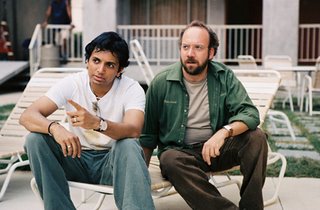The Lady in the Water
 I have defended M. Night Shyamalan in the past but I’m afraid I cannot defend his latest film. For all its weirdness The Lady in the Water fails to create anything more than a strong sense of regret in all who see it. Vapid and shamelessly arrogant, The Lady in the Water is the worst movie Shyamalan has ever packaged for mass consumption—and probably one of the worst movies of the year.
I have defended M. Night Shyamalan in the past but I’m afraid I cannot defend his latest film. For all its weirdness The Lady in the Water fails to create anything more than a strong sense of regret in all who see it. Vapid and shamelessly arrogant, The Lady in the Water is the worst movie Shyamalan has ever packaged for mass consumption—and probably one of the worst movies of the year. Paul Giamatti delivers a dependably solid performance as the unfortunately named Cleveland Heep, the superintendent in an apartment complex in Philadelphia called “The Cove.” He lives there with a colorful assortment of ethnic stereotypes. These characters are painful, as they appear to be acting not as individual human beings but as puppets spouting Shyamalan’s drivel. Seriously, my Sims have more depth of character than these people. Ironically, the only person in The Cove that has anything remotely interesting to say is Harry Farber (modern master of the deadpan Bob Balaban) a “film and book critic.” Farber provides some of the only moments of intentional levity in the film, describing obvious clichés as they occur and expressing cynicism about all things fantastic and beautiful. He states that “there are no original ideas left.” Boy, he’s not kidding.
One night, Cleveland Heep discovers a young woman in the pool, played with wide-eyed innocence by Bryce Dallas Howard, who turns out not to be a human at all, but a sea nymph from a place called “The Blue World.” No, that’s not a strip club out by the airport—it’s a world populated by helpful, naked people (much like a strip club out by the airport). These sea nymphs, called “narfs” in the movie, have apparently been sent to humankind in order to convey some sort of message about how M. Night Shyamalan’s creative genius will someday change the world. Okay, now, you think I am using hyperbole, but you’re wrong. Actually, this narf, who calls herself “Story” (sigh) comes into contact with Vick Ran (Shyamalan) and tells him that he will write a great work, one that will be read by the future leader of the United States, and his influence will shape the development of our nation and, eventually, the world. Of course, she says, his work will not be understood by many and that he will not become beloved until after he is slain for his radical beliefs (sigh). Yes, ladies and gentlemen, the writer/director of this film actually tells us we’re too stupid to be watching this movie while we’re watching it. I don’t like being told I’m an idiot (although, I did pay eight dollars to see this film, so I guess that does kind of make me an idiot. Damn you, Shylamalan!). The Lady in the Water is, above all things, treatise on the brilliance of Shyamalan's storytelling. In the process of cumbrously dissecting his ouevre, however, he wrings every last drop of magic out of his precious little fairytale.
Of course, Story can’t get home to The Blue World because of the scrunts, nasty little beasties that look like a cross between a wolf, a hedgehog and an actual hedge. Yes, these grassy little werehedges tear up Story’s million-dollar legs and prevent her from being carried home by—get this—a giant eagle. Don’t ask me why a giant eagle would be transporting a sea nymph back to her underwater castle. Maybe it’s an eagle that likes to snorkel.
The Lady in the Water begins with an animated prologue that explains the plot so well that we already feel ten steps ahead of the tenants in The Cove before the movie even begins. Hilariously, Shyamalan tries to pass his fantasy creatures off as being part of an “old Korean bedtime story.” Give me a break (and some heroin to kill my pain).
I read in The New York Observer that Disney execs danced around Shyamalan for months before finally admitting to him that they did not understand his hopelessly ridiculous and convoluted script. See, now, this is the problem. Audiences, critics and producers alike have to be able to gird their loins and admit when something is just plain stupid. You can’t be afraid to criticize self-described genius for fear of sounding dumb. Thus far, I have been reading the reviews of The Lady and trying to discern who, in their right minds, would give the film the thumbs up. Wesley Morris of The Boston Globe said this: “There is a good chunk of ‘Lady in the Water’ that is simply too well made and affectingly acted to dismiss as a mere exercise in arrogance.” Actually, Mr. Morris, it can be dismissed. It can be and it will be, and the fact that you do not have the cajones or simply the basic command of the English language necessary to call Shyamalan out for this self-indulgent piece of tripe is probably why you are stuck writing for the the Globe in the first place.
But enough of putting down poor Mr. Morris. Let’s look at some of the other positive reviews, shall we? Torn Long (who, judging by his name, also works stripping at The Blue World) of the Detroit News says, “It tells a story that is both daringly literary and shockingly direct, with sudden bursts of expositional information followed by dizzyingly complex character crossovers.” The only thing dizzying about this film was the shameful excuse for cinematography by the often competent Christopher Doyle (The Quiet American). If Shyamalan is really trying to present us with a revisionist modern-day magical realist fairytale, maybe he should do a little reading and take a lesson from professionals like Salman Rushdie, Angela Carter and Geoffrey McGuire. Just because a man makes up a story that entertains his daughter does not mean that the world will benefit from its widescreen release. Have a little humility, you pompous twat.
And finally, let’s take a look at Kevin Lafores of The Montreal Film Journal, who says: “Why don't people recognize it as an instant classic like Spielberg's own bedtime story? How is it sillier than an extra-terrestrial stranded in a backyard who needs help from suburbia kids to phone home and return to his planet before the army gets to him? Easy: Night had the balls to make almost all of his characters full-grown adults.”
No, Mr. Lafores, the difference is that Spielberg understood the importance of pacing and character development. Mr. Shyamalan, who is normally much more deft when it comes to maintaining the suspesion of disbelief, totally drops the ball when it comes to making this fantasy believable. If his point is that we should be able to believe in magic in a cynical world, then maybe he should make more than a half-assed attempt to convince us.
I have collected a number of bad reviews that I thought were especially fun to read. Enjoy:
The amount of money they would have to pay me to sit through this again: $10





